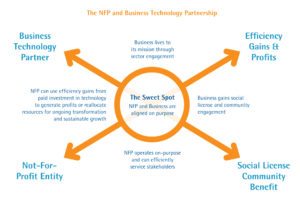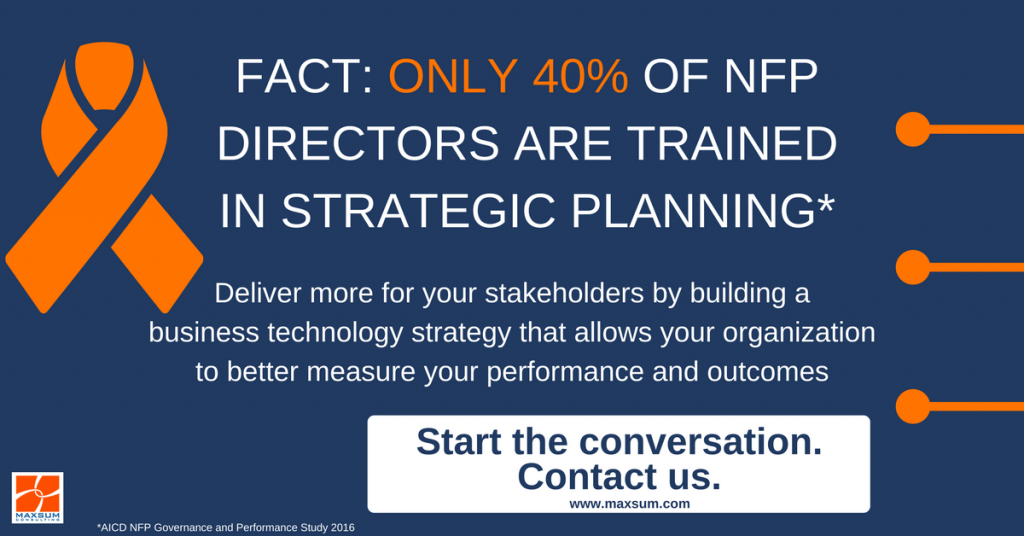[vc_row][vc_column][vc_column_text] And…why “profit” need not be a dirty word! At recent Not-for-Profit forums the overriding message has been that for for-purpose and for-profit organisations alike, change is the new norm. While the NFP sector is traditionally seen as being highly risk averse, they too are now facing the urgent need to adapt to new service delivery needs, address new governance issues and escalating cyber threats, examine scope for automation and embracing data and analytics to better serve their stakeholders and expand their impact.
The problem for NFP decision makers though is that embarking on a digital transformation takes time, expertise and investment – resources that NFPs are not necessarily positioned to be able to sustainably fund without a profit model. And therein lies the conundrum and innovation vs. risk challenge – how can the NFP justify generating enough of profit that will enable it to invest in sustainable and positive business technology outcomes, whilst still remaining true to its purpose?
A solution? A true and open partnership between the NFP and business sector where both sides are clear about their aims, expectations, desired efficiency gains and, yes, profit. Profit is not a dirty word. Rather, it is a tool that the NFP can utilize to implement strategic and sustainable systems and processes for better outcomes. And the reality is that, going forward, traditional funding models will not be sufficient or agile enough for NFPs to actual embrace, invest and execute meaningful change fast enough. This is where the business sector has great potential to partner with NFPs for their mutual benefit. Where working together, we can get 1+1=3.
But just as NFPs need to look at their views on profits, the business sector needs to re-examine our perception that NFPs are risk-averse. If you consider what the purpose of an NFP is, it is often the case that they are designed to serve and aid segments and persons in the community who are most at risk, or who might even pose varying degrees of risk to the NFP’s assets, staff, and funding options. Clearly there is, in their very ethos for being, a greater risk-appetite in the NFP sector than the for-profit business sector gives them credit for.
Talking to people in the NFP sector, their organizations and boards are grappling with the same questions as the business sector. The risks and challenges insect across both sectors, and the strategic challenge NFPs also face now is how to bolster their organization by strengthening their purpose, culture and people: how to have these three elements tightly aligned, relevant to their vision, and “fit for purpose”.
This is exactly what boards in the business world are seeking to do too and the endgame is actually the same: they’re just on different sides of the same coin. The business world is seeking to make strategic change to deliver output, productivity and user experience gains for profit whilst also raising their social profile, and the NFP sector is seeking to make a greater impact and provide a better experience for those it serves, but also remain financially viable and able to grow sustainably.
So how to cultivate these best-fit, 1+1=3 partnerships between NFPs and business?
- Encourage diversity of thinking in the boardroom: NFP boards need to draw on the business sector and give them a seat at their table while the business sector has role in demonstrating to NFPs the benefits of outsourcing and investing in new technologies and modelling how profits can be reinvested in transformation projects.
- Maintain an open dialogue from the outset where both parties are clear and upfront about their respective purposes. Gaining alignment on purpose is central to making the partnership work.
- Ensure that the NFP and business work together to promote open, honest and regular communication with stakeholders to build transparency around the aims and outcomes of partnerships between NFPs and the business world.

Finding that strategic “sweet spot” where the NFP and For-Profit business purposes align and intersect will be a vital for both NFPs and for-profit businesses to achieve their strategic aims amidst ever-accelerating and disruptive change. Let’s check our preconceptions at the door and get around the board table together to talk openly about partnerships for profit, managing risk, building strategy and generating sustainable outcomes.
Give Maxsum a call today on 1300 629 786 or contact us here, to give business technology a seat at the decision-making table in your not-for-profit organisation.



